Home / Partial Reduction of Alkynes With Lindlar’s Catalyst
Alkyne Reactions
Partial Reduction of Alkynes With Lindlar’s Catalyst
Last updated: January 23rd, 2024 |
Partial Reduction of Alkynes to cis Alkenes with the Lindlar Catalyst
- Alkynes are generally more reactive towards catalytic hydrogenation (e.g. Pd-C, H2) than alkenes
- While it’s possible to partially hydrogenate an alkyne to an alkene by limiting the number of equivalents of hydrogen gas, it’s not very convenient (since it requires equpiment such as a gas buret, and is impractical to do on small scales).
- An alternative approach is to make the Pd-catalyst less active for hydrogenation by “poisoning” it, often with lead salts (Pb) and amines (such as quinoline). The combination of Pd supported on calcium carbonate (CaCO3) that has been treated with a small amount of lead (often Pb(OAc)2 ) is known as “Lindlar’s catalyst”.
- Lindlar’s catalyst always gives cis alkenes from alkynes. Alkenes are not hydrogenated.
- Alternative reagents that are equivalent to Lindlar’s catalyst include Pd on barium sulfate (Pd/BaSO4) with quinoline, as well as nickel boride (Ni2B).
- The stereochenistry of this reaction is very commonly tested in exams, expecially in combination with reactions of alkenes that are also stereospecific (e.g. halogenation, dihydroxylation).
- Note that it’s also possible to partially reduce alkynes to trans-alkenes through the use of sodium in ammonia (Na/NH3) – See article – Partial Reduction of Alkynes to Trans Alkenes)
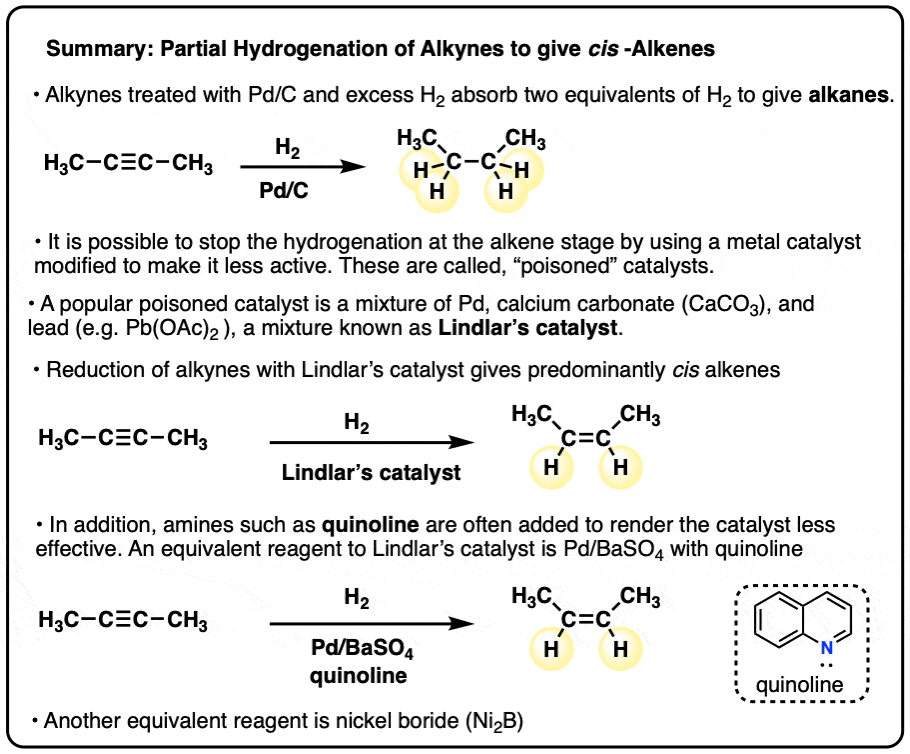
Table of Contents
1. Partial Hydrogenation of Alkynes to Alkenes With Lindlar’s Catalyst
We’ve seen that catalytic hydrogenation is a useful reaction for converting alkenes into alkanes. [See article: Catalytic Hydrogenation of Alkenes]
In catalytic hydrogenation, hydrogen gas is adsorbed onto the surface of a “late” metal (usually palladium or platinum) that has been dispersed on a high surface-area material such as activated carbon.
Alkenes and other unsaturated molecules readily bind to late metals through their pi-bonds. When an alkene lands on a metal packed with hydrogen on its surface, an addition reaction occurs where two new C-H bonds are formed and a C-C pi bond is broken, generally with syn stereoselectivity. This produces an alkane.
When alkynes are used in place of alkenes in the presence of Pd-C and H2, both double bonds are hydrogenated, also resulting in an alkane:
This reaction is often referred to as a “reduction” since the oxidation state of carbon is lowered during this process (oxidation state of each carbon in the neutral alkyne is zero; oxidation state of each carbon in the alkane is -2. See article – Calculating the Oxidation State of Carbon).
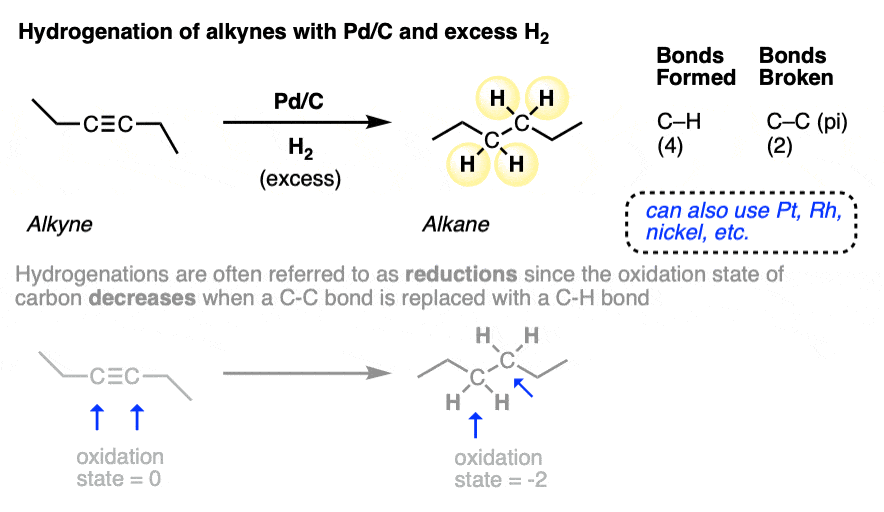
Forgive me for my lack of excitement, but I think the proper reaction to this particular reaction is, “big whoop”.
I mean, making alkanes from alkanes is fine if your plan is to make margarine or something. But from a chemical synthesis perspective, it’s a waste of a potentially useful functional group.
Why? Well, we’ve just seen that acetylide ions are extremely useful for making C-C bonds through reaction (SN2) with alkyl halides. (See article – Substitution Reactions of Acetylides). For the first time, this gave us a method for building up longer carbon chains from smaller ones.
Using this reaction just for making longer alkanes isn’t exactly exciting because there aren’t that many interesting reactions of alkanes aside from 1) free-radical substitution, which we’ve seen is a pretty poorly selective reaction, (link), and 2) combustion, which kind of defeats the whole point of synthesis in the first place.
You know what is exciting, though? Reactions of alkenes.
It would be really useful to get our alkyne to accept only one equivalent of H2. Then we’d have an alkene, and we’d unlock the many useful reactions of alkenes we’ve learned previously. [See Article – Reaction Map of Alkenes to give you a fuller perspective] This would allow us to build in all kinds of functional groups – alcohols, alkyl halides, epoxides, and many more – that just aren’t readily available from boring ol’ alkanes. [Note 1]
As it turns out, alkynes are more reactive towards hydrogenation than alkenes. It is possible to get an alkyne to accept just one equivalent of H2, if one is very careful with doling out a single molar equivalent using a gas buret or similar.
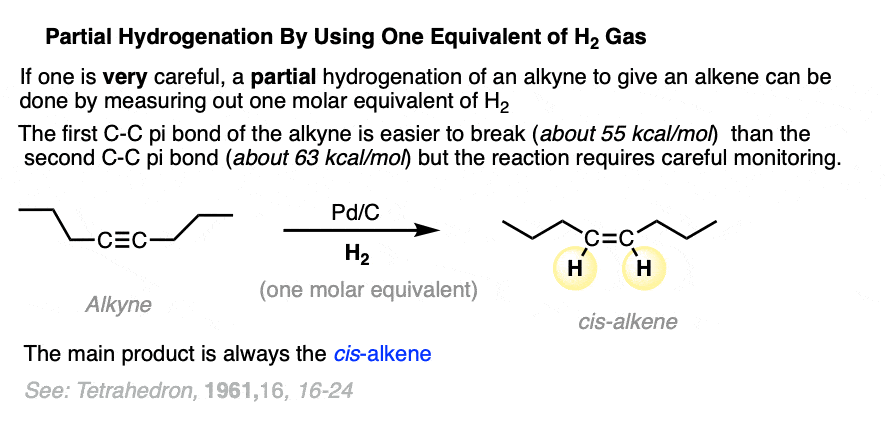
Note that while I say it is possible, it’s not actually all that convenient, since you need to set up an additional piece of equipment, and furthermore it can be tricky to accurately measure out one molar equivalent of H2 on small scale.
A simpler alternative for partial hydrogenation is just to make the catalyst worse.
Wait, what?
Yes, make it worse. Since alkynes are already more reactive than alkenes, just poison the catalyst enough so that is unable to carry out the hydrogenation of alkenes. Problem solved!
The most commonly used “poisoned” catalyst is Lindlar’s catalyst, which is a mixture of palladium, calcium carbonate, and traces of lead (Pb). Quinoline, an aromatic amine, is sometimes added to help with selectivity. . [Described in more detail here Note 2].
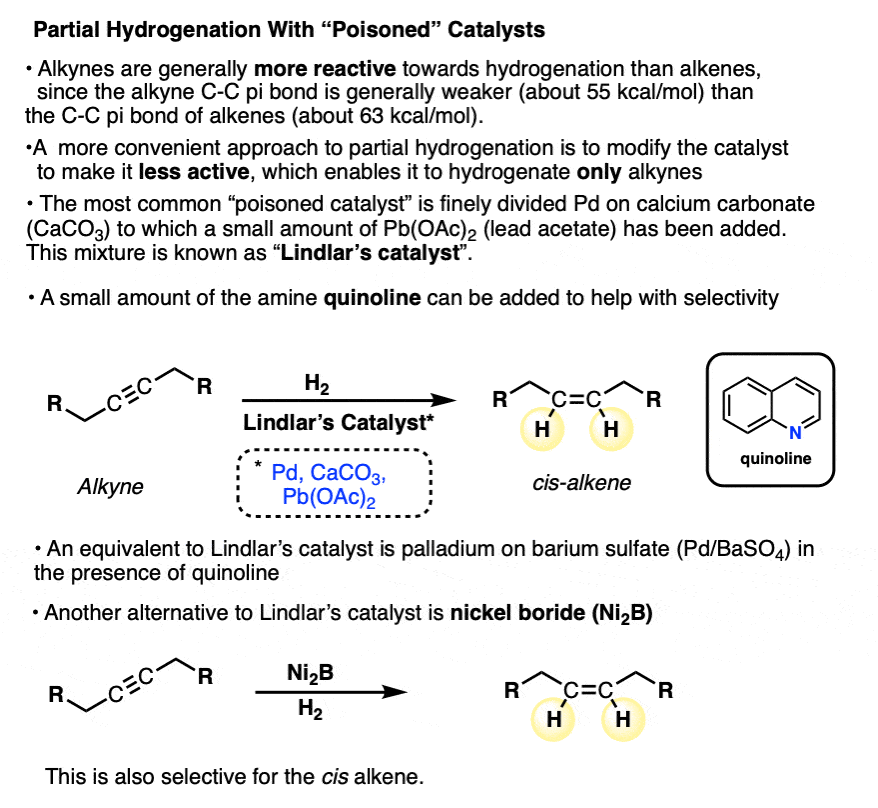
The “poisons” here are a lead (Pb) and amine [quinoline]. It is thought that lead (Pb) acts to reduce the bonding of H2 to the metal, while the amine (quinoline) helps to avoid unwanted byproducts. (See reference here)
Another reagent that sometimes sees use is nickel boride (“Ni2B”), which for our purposes can be considered to be equivalent to Lindlar’s catalyst. It is used in the presence of hydrogen gas. [Note 3]
2. Lindlar’s Catalyst: Examples
One advantage of Lindlar’s catalyst is that it is selective for the reduction of alkynes. Alkenes are not affected. The stereochemistry of the alkene produced is always cis.
Furthermore, aromatic rings such as benzene are also unaffected (the unusually low reactivity of benzene is covered in a subsequent chapter – see Introduction to Aromaticity).
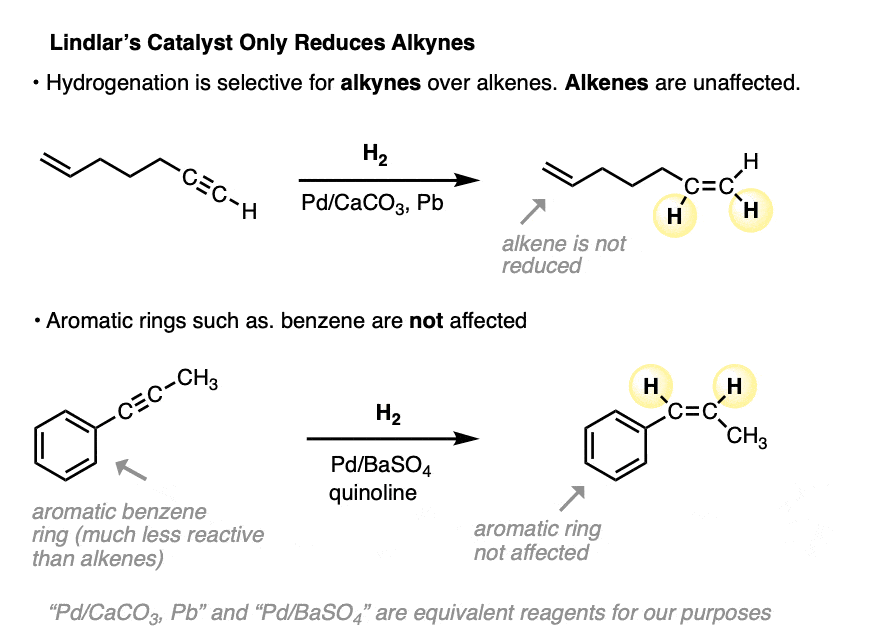
Deuterium, the heavy isotope of hydrogen, can be used in place of hydrogen gas.
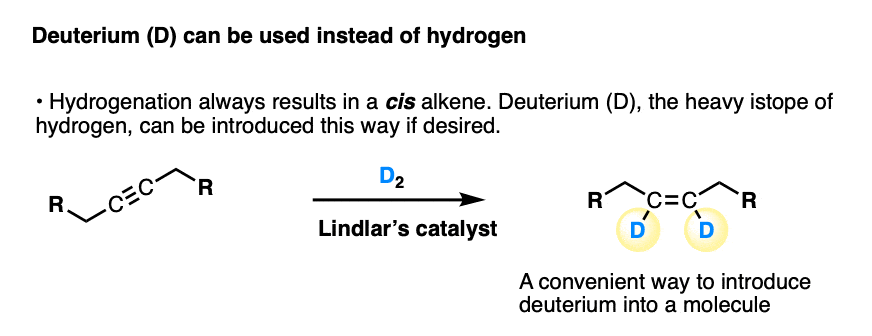
3. Applications of Lindlar’s Catalyst
As mentioned above, a key feature of partial hydrogenation of alkynes is that it unlocks all the reactions of alkenes.
For example, alkynes don’t undergo epoxidation with m-CPBA or dihydroxylation with OsO4. But alkenes do!
See if you can draw the product that is formed when an alkyne is partially hydrogenated with Lindlar’s catalyst and then treated with OsO4.
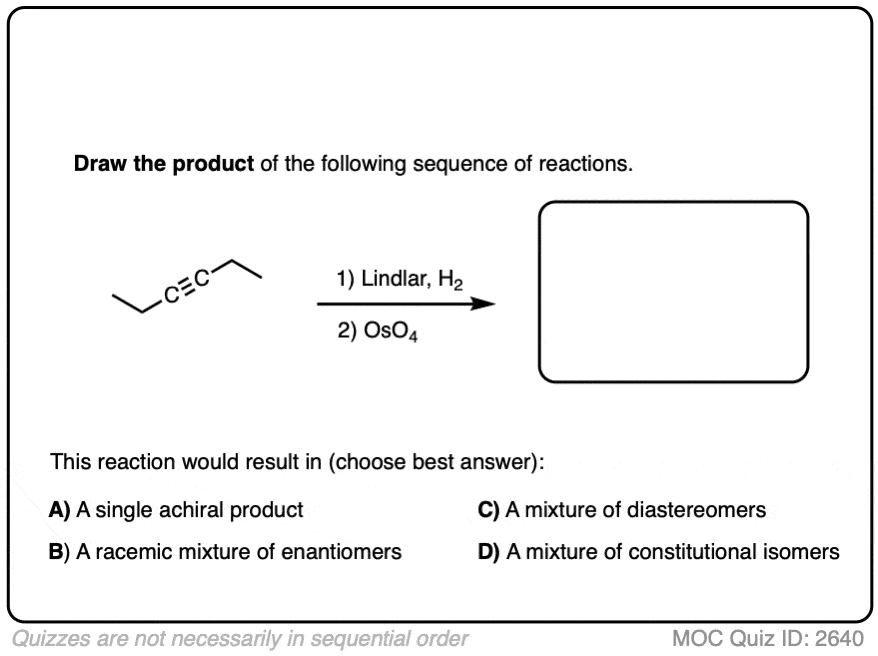 Click to Flip
Click to Flip
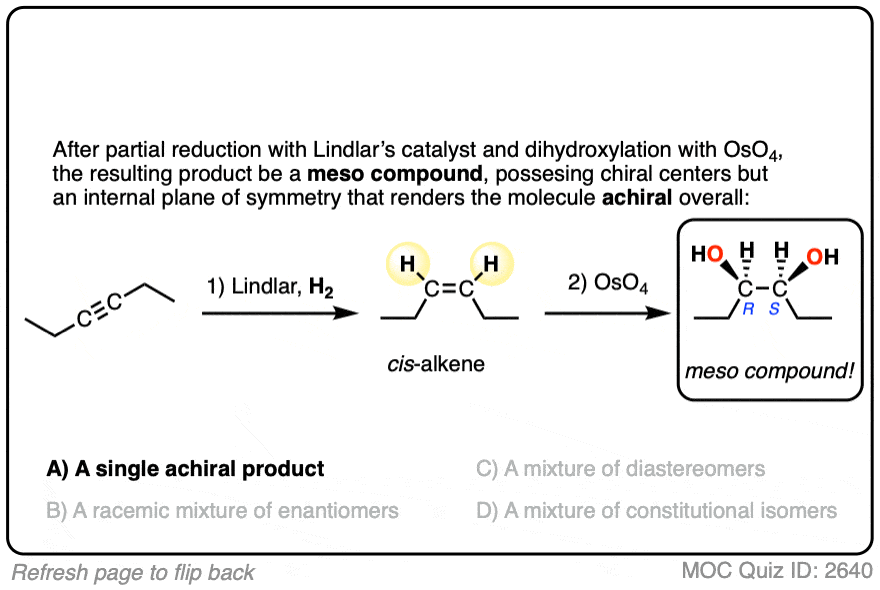
In these types of quiz questions, it’s very important to pay close attention to the stereoselective nature of the Lindlar reduction.
Lindlar’s catalyst is notable in that it makes cis-alkenes from alkynes. Another reagent, sodium in ammonia (Na/NH3) can reduce alkynes to trans-alkenes. (See article – Reduction of Alkynes to trans-Alkenes With Na/NH3).
Keeping stereochemistry straight is extremely important both in the forward (i.e. predicting the products) and reverse directions (e.g. synthesis problems, see below).
Try this example with halogenation.
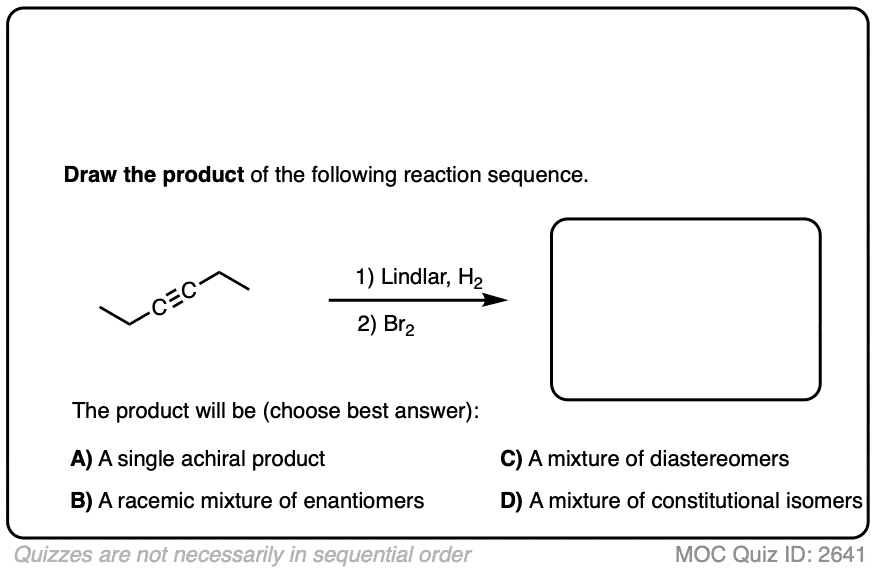 Click to Flip
Click to Flip
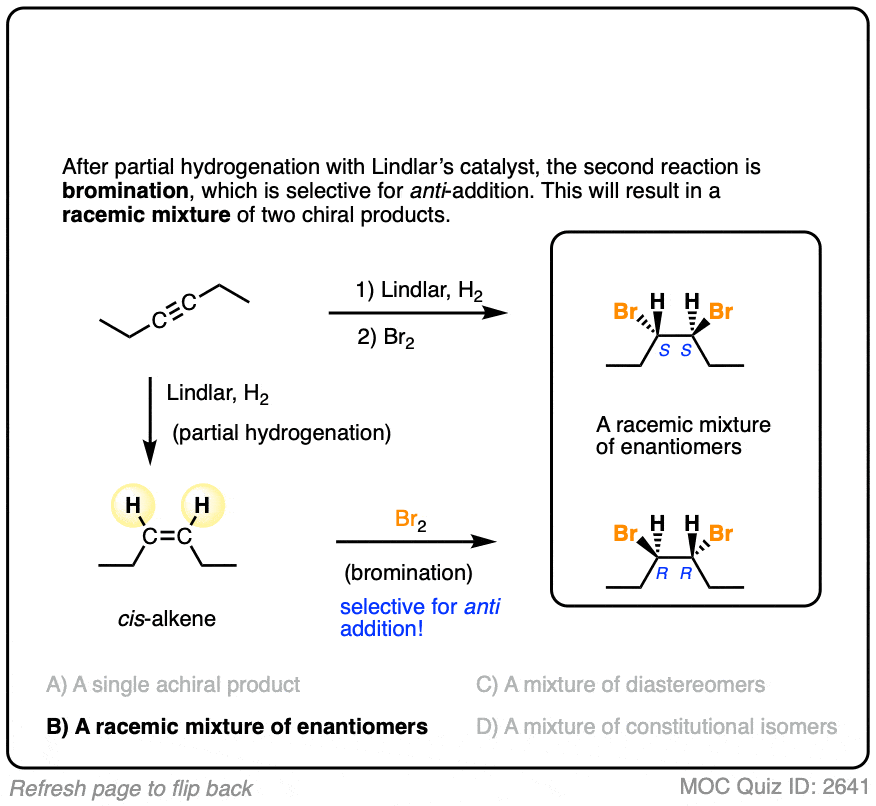
Here is an example incorporating the addition of HBr :
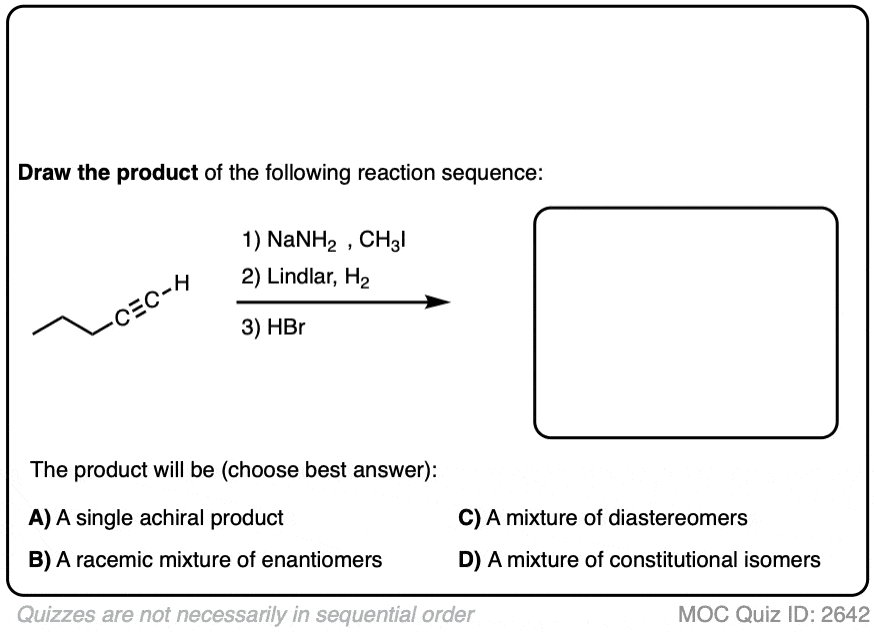 Click to Flip
Click to Flip
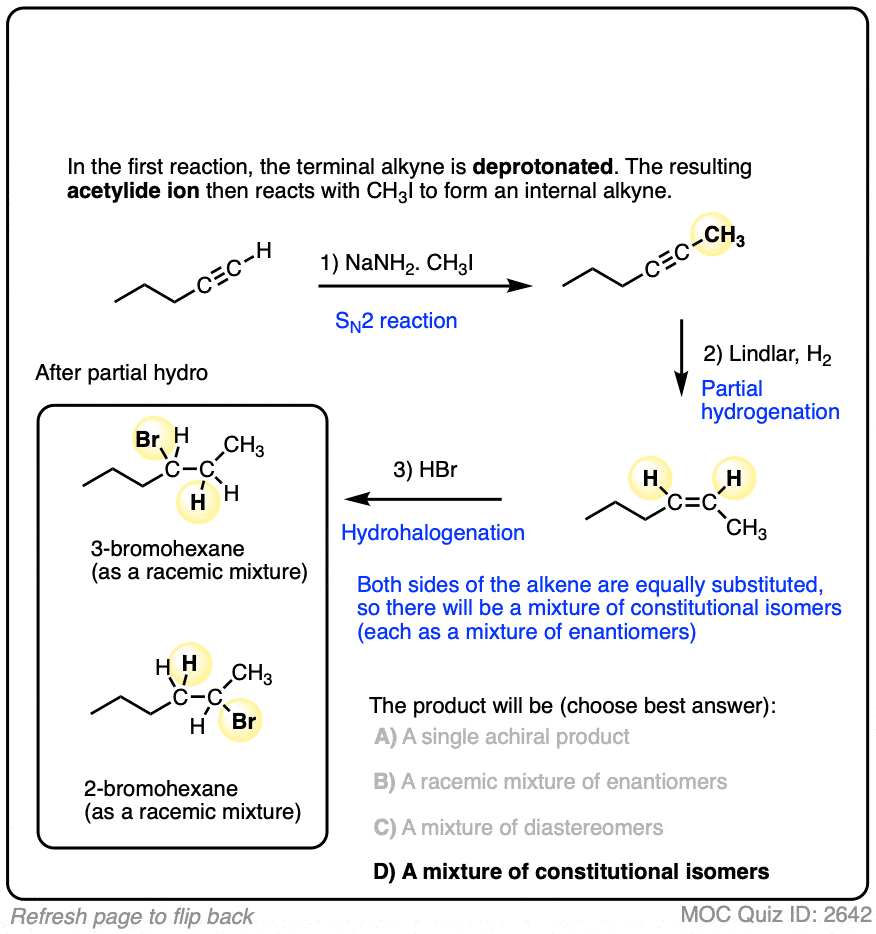
Yes – even though we’re in the chapter on alkynes, Markovnikov’s rule still applies :-) .
Finally, an epoxidation example:
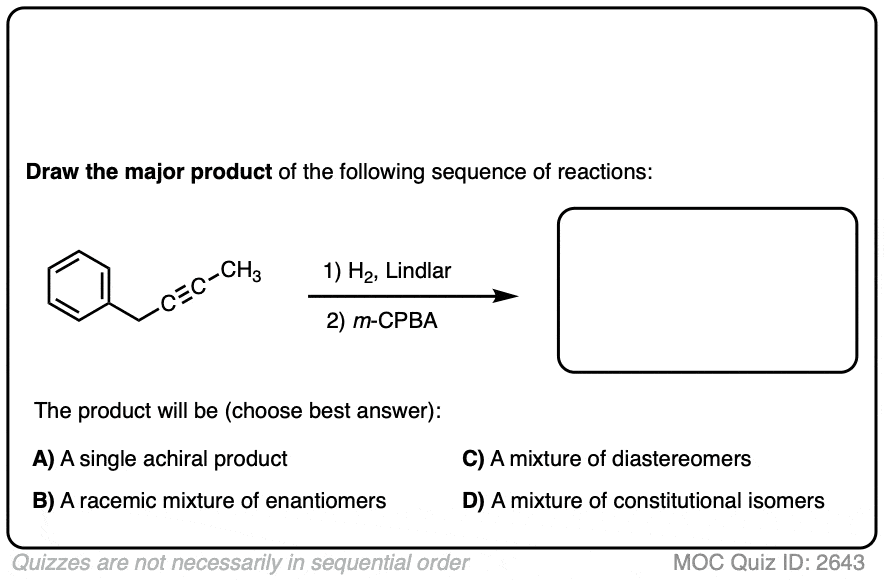 Click to Flip
Click to Flip
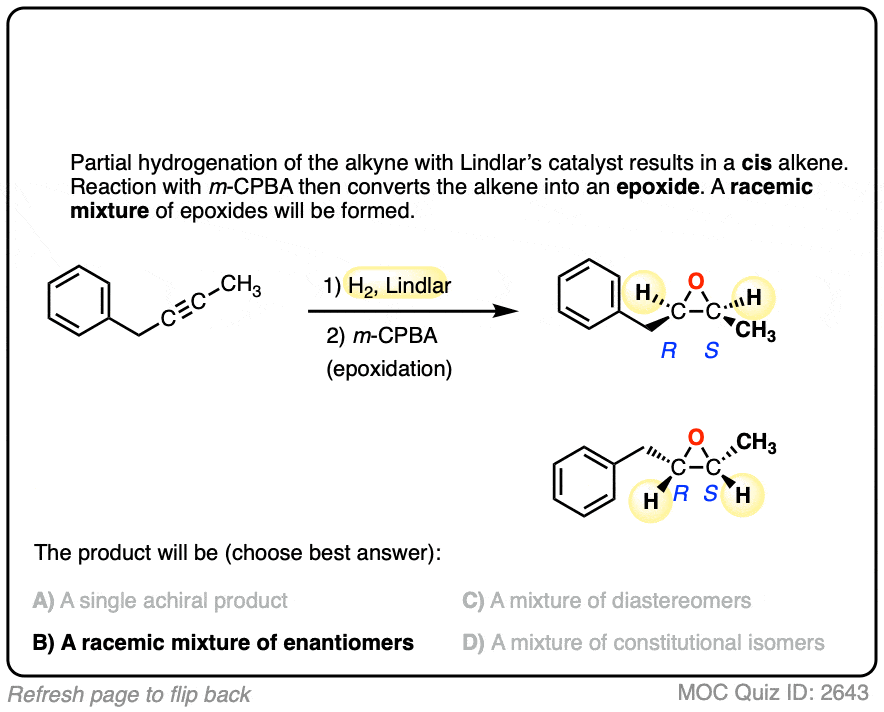
4. Synthesis Questions With Lindlar’s Catalyst
Now that we have a reaction for building up the carbon chain (acetylide alkylation) and a reaction for converting alkynes to alkenes (partial hydrogenation) a whole world is opening up before us.
We can finally think about how we would carry out the synthesis of larger molecules from smaller molecules through a series of well-planned reactions.
It’s like putting together Lego bricks, but instead of pushing Lego nubs into the holes of another brick, we’ll be adding nucleophiles to electrophiles.
Here’s a typical example. How would you synthesize this diol from the alkyne (below left) using any inorganic reagents and carbon fragments with two carbons or less?
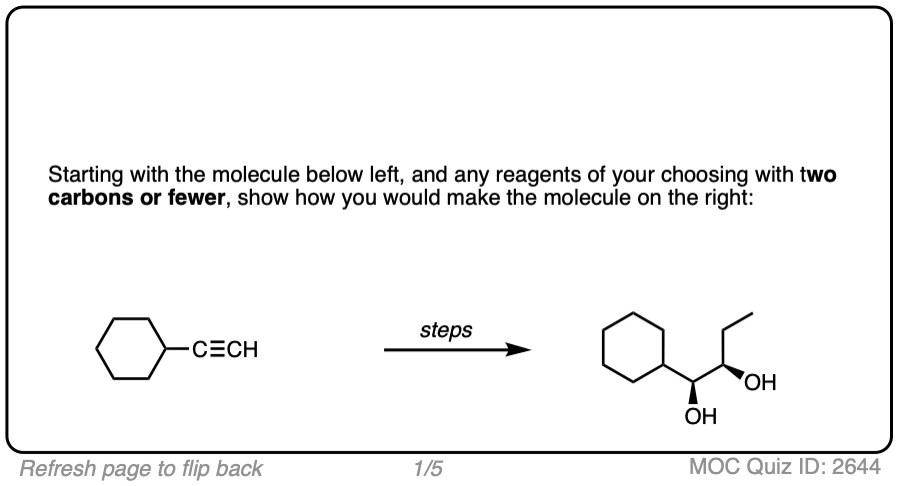
What's different? What bonds have formed and broken?
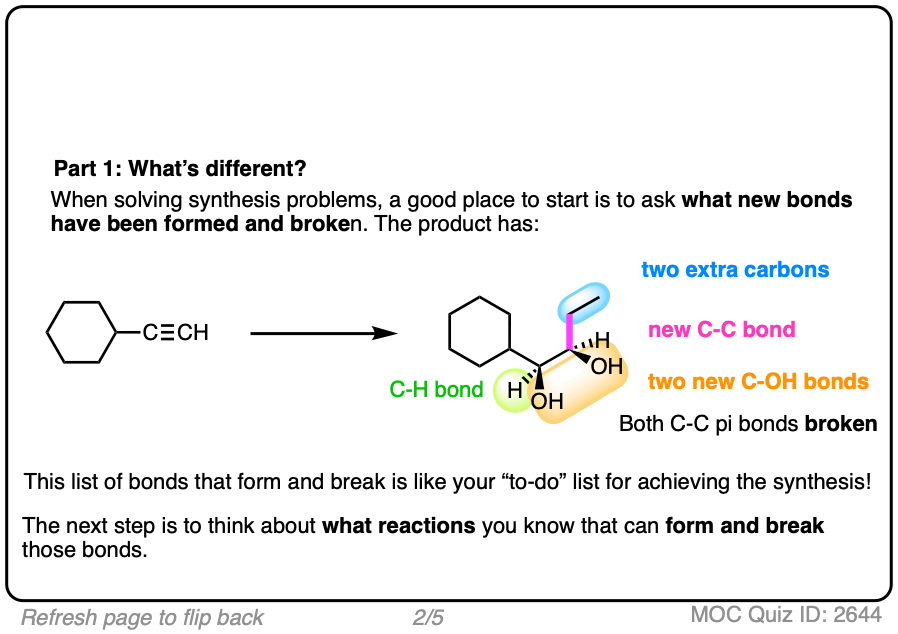
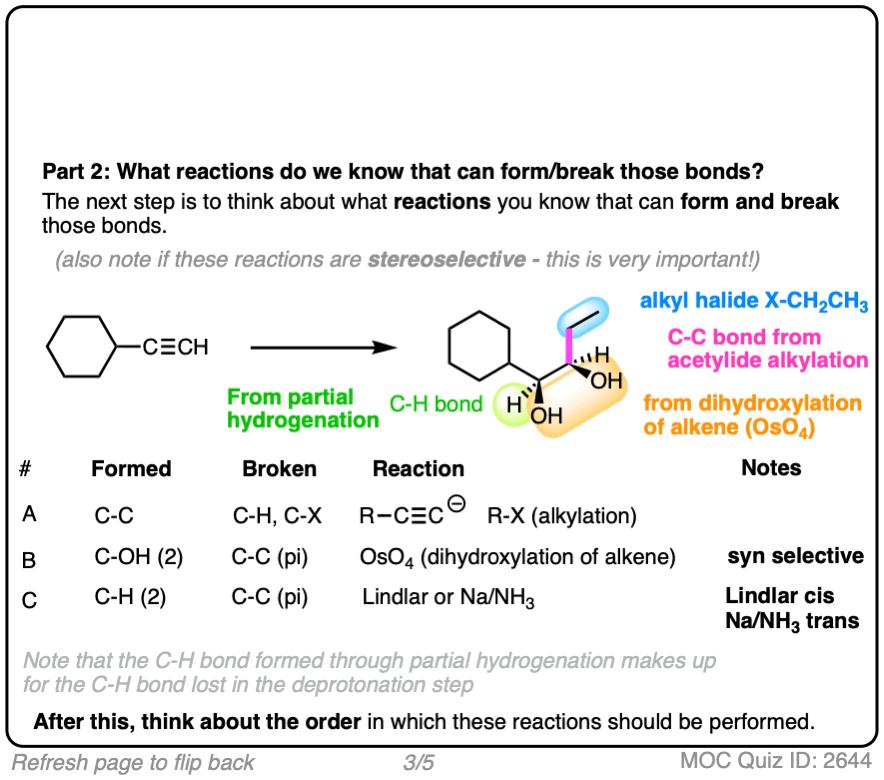

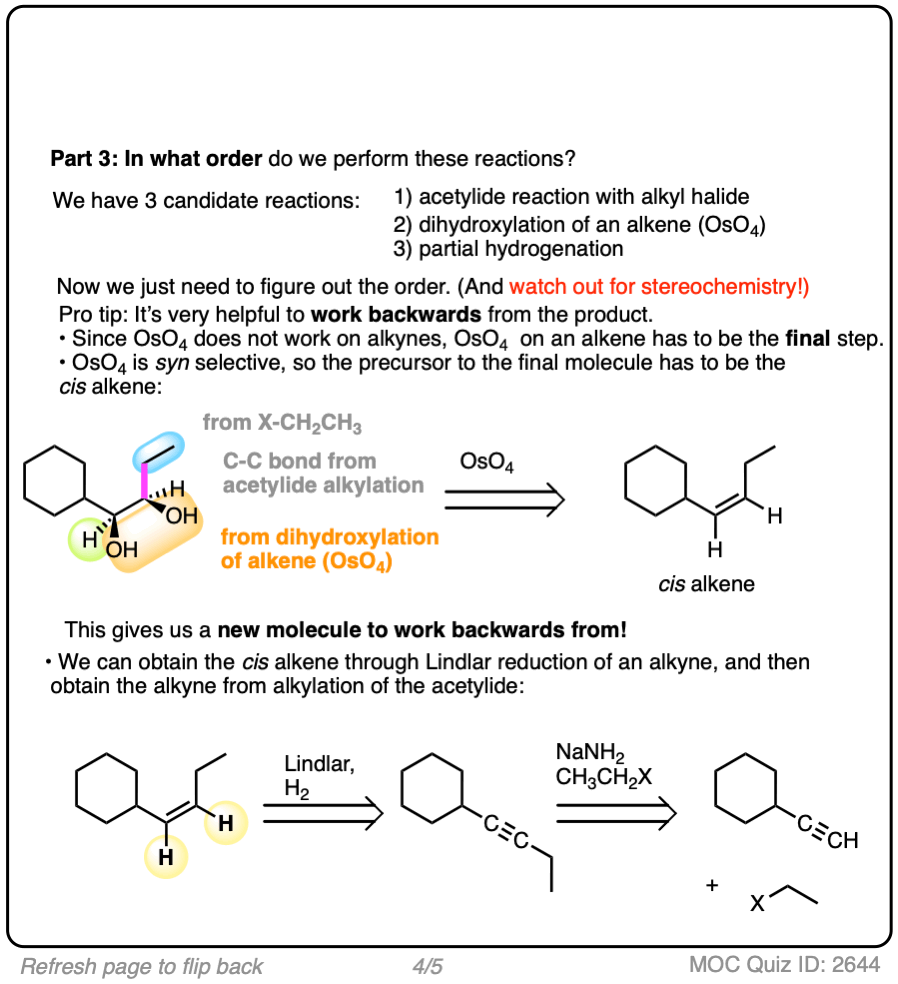
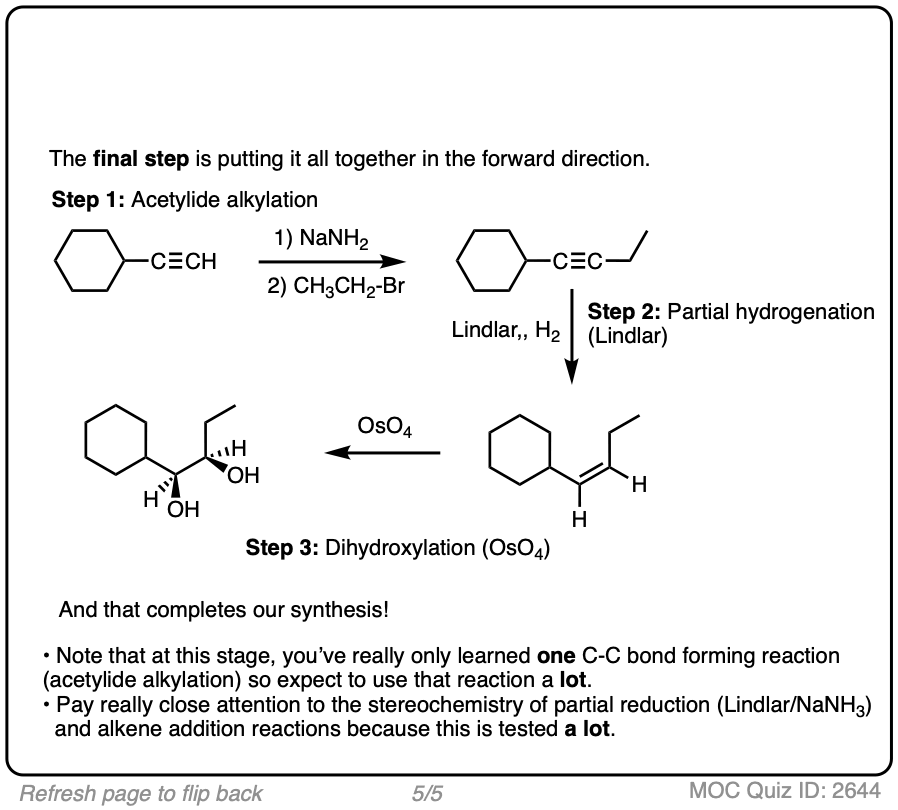
Working on these types of problems takes some practice. I’ll have more to say about it elsewhere, but when working on these problems, I advise breaking it down to the following exercises:
- Examine what’s new – what specific bonds have formed (and broken) in going from the starting material to the product? This is your to-do list.
- What reactions do you know that form and break those bonds?
- In what order do we need to do these reactions?
Once you’ve answered these questions, you can start thinking about how you would carry out the sequence in a forward direction.
One key factor not to be forgotten is the importance of stereochemistry.
When planning out these reactions, it’s not enough to know that, say, Lindlar’s catalyst does the partial reduction of an alkyne to an alkene. It’s crucial to also include that the reduction occurs in a cis fashion. If you leave out that detail, you won’t get full credit for your answers.
Here’s another example of a synthesis problem involving epoxidation (m-CPBA).
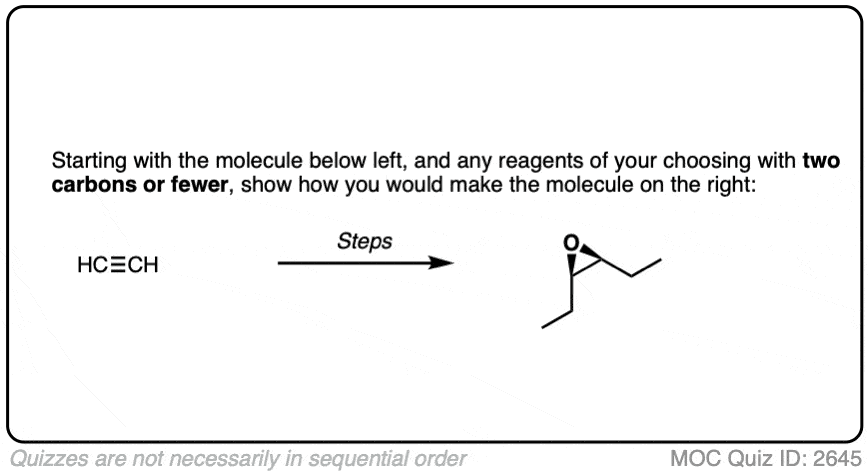 Click to Flip
Click to Flip
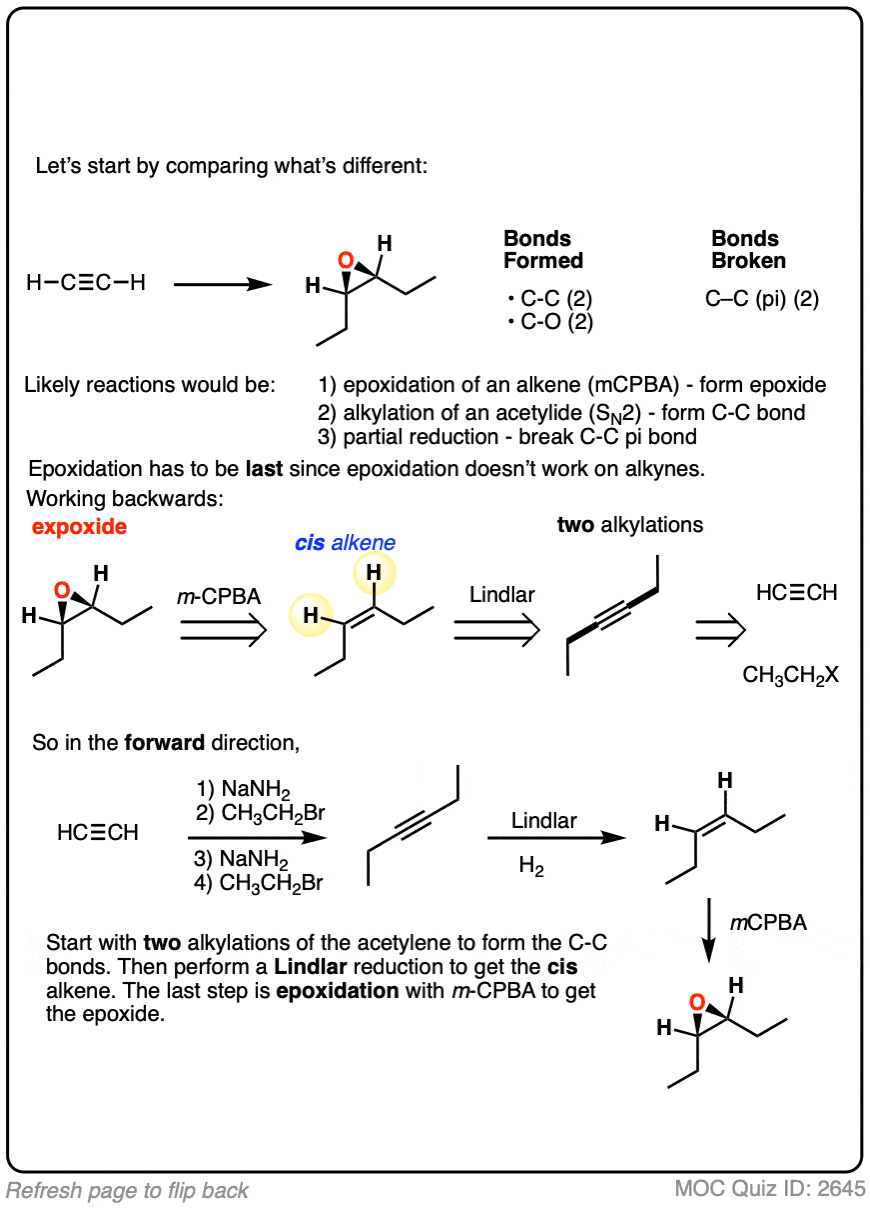
Here’s another example of a synthesis question that involves chlorination (remember that this is selective for the anti-addition product.
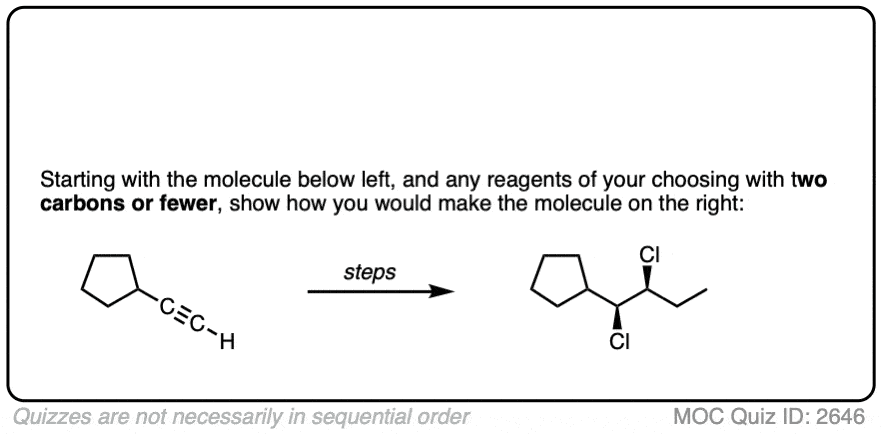 Click to Flip
Click to Flip
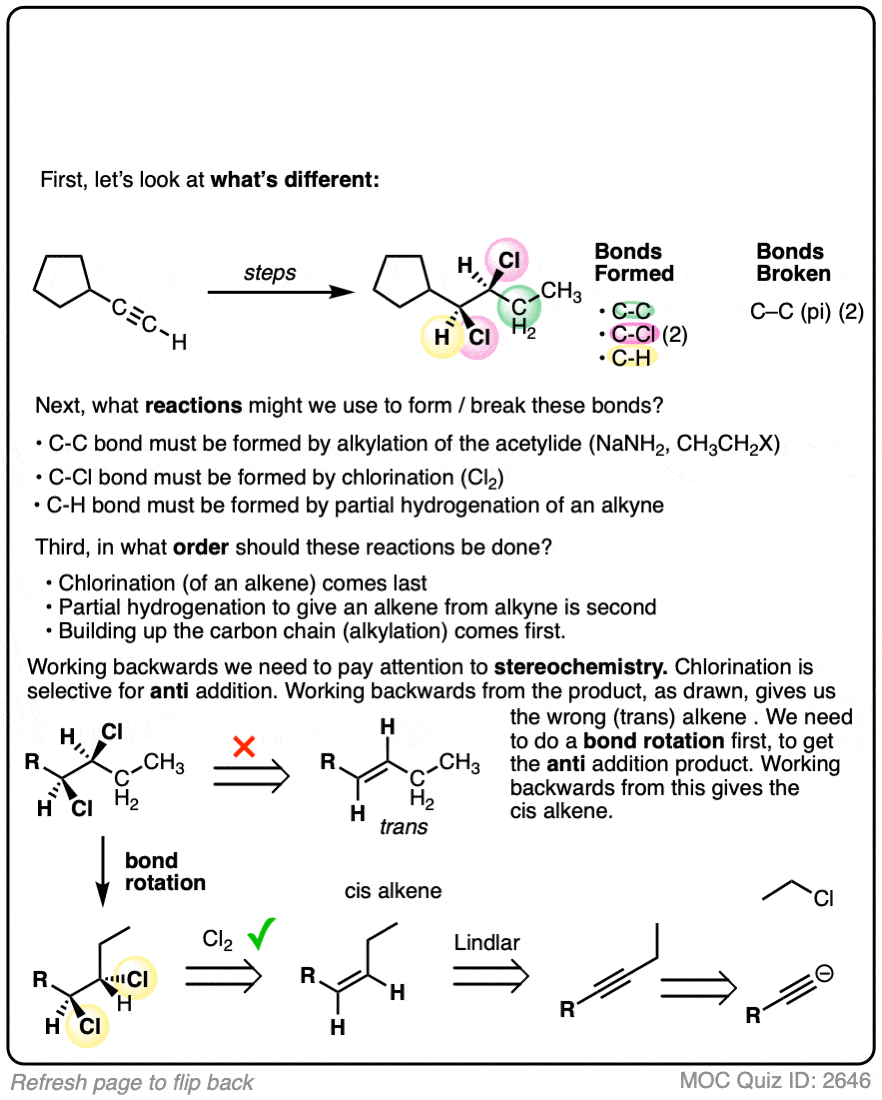
In this example, we had a vicinal dihalide that was drawn in a conformation where both C-Cl bonds were wedges. If we worked backwards from this without accounting for the stereochemistry, we’d end up with the wrong double-bond geometry.
5. Summary
Lindlar’s catalyst is used for the partial reduction of alkynes to cis-alkenes. Be on the lookout for synthesis questions involving Lindlar’s catalyst and pay close attention to stereochemistry.
In the next article we will cover a reaction for the partial reduction of alkynes to give trans alkenes, Na/NH3 (sodium in ammonia).
Notes
Related Articles
- Palladium on Carbon (Pd/C) for Catalytic Hydrogenation
- Partial Reduction of Alkynes With Lindlar’s Catalyst or Na/NH3 To Obtain Cis or Trans Alkenes
- Alkyne Hydroboration With “R2BH”
- Calculating the oxidation state of a carbon
- OsO4 (Osmium Tetroxide) for Dihydroxylation of Alkenes
- m-CPBA (meta-chloroperoxybenzoic acid)
- Synthesis (4) – Alkene Reaction Map, Including Alkyl Halide Reactions
- Acetylides from Alkynes, And Substitution Reactions of Acetylides
- Halogenation of Alkenes and Halohydrin Formation
- Hydrohalogenation of Alkenes and Markovnikov’s Rule
Note 1. One of the outstanding challenges in modern organic chemistry – a “holy grail“, if you will – is actually how to take a relatively unreactive functional group like an alkane C-H bond and transform it to a more reactive functional group such as C-OH or C-Cl with high selectivity. This extremely active area of research is known as “C-H activation“.
Note 2. Technically, Lindlar’s catalyst is Pd on calcium carbonate that has been treated with a trace amount of lead salt (the procedure is here). It has been found that addition of small amounts of quinoline also helps with selectivity (so do certain thiols).
Note 3. Nickel boride is made through the reduction of Ni(II) acetate with sodium borohydride (NaBH4) in methanol. It is a hydrogenation catalyst. A representative procedure can be found here.
Quiz Yourself!
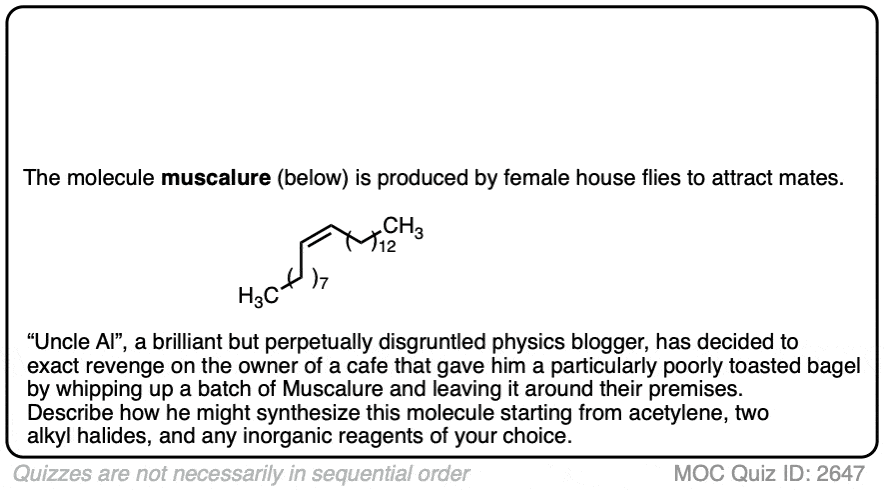 Click to Flip
Click to Flip
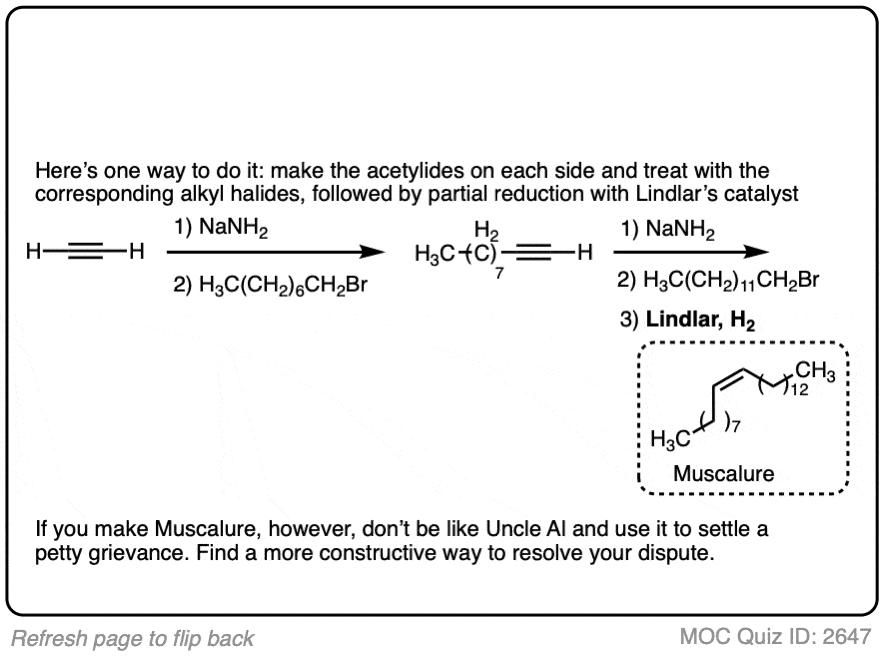
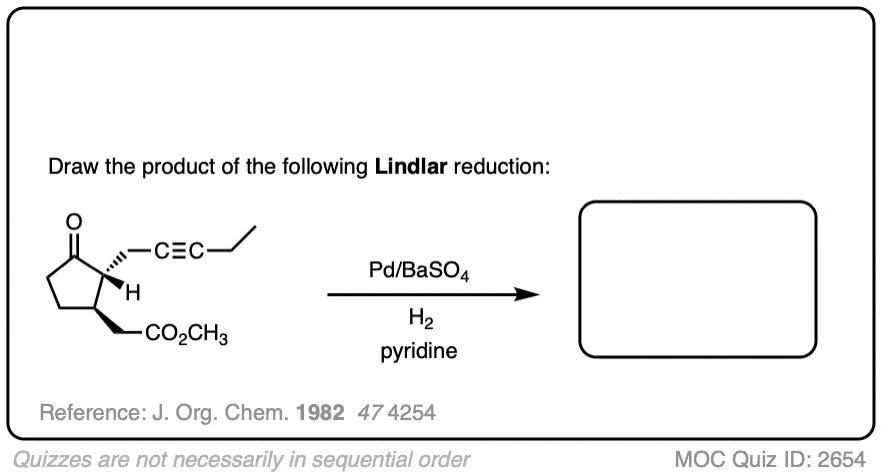 Click to Flip
Click to Flip
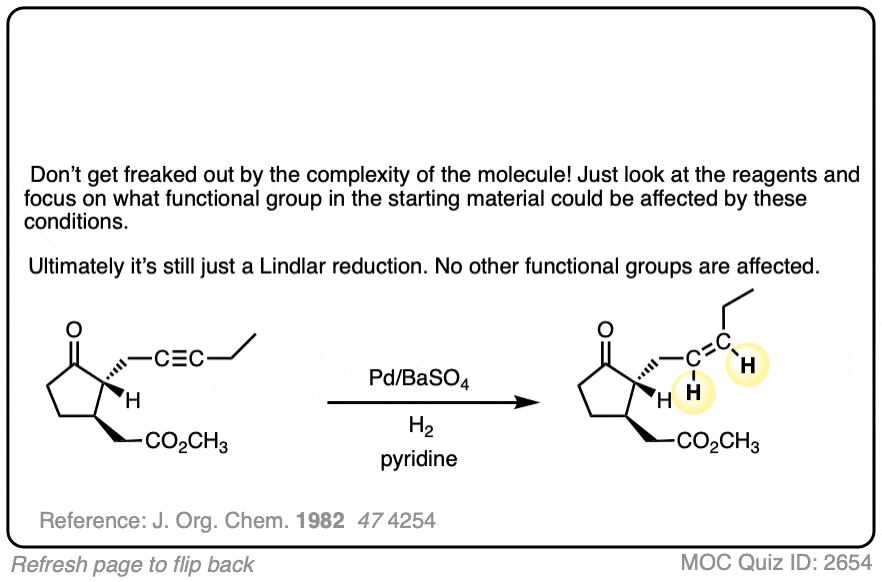
(Advanced) References and Further Reading
- Catalytic Semihydrogenation of the Triple Bond
Elliot N. MARVELL*, Thomas LI
Synthesis 1973, 457-468
DOI: 10.1055/s-1973-22234
Fairly comprehensive review, still relevant today, on various methods for partial hydrogenation of alkynes. - Ein neuer Katalysator für selektive Hydrierungen
H. Lindlar
Helv. Chim. Acta 1952 35 (2), 446
DOI: 10.1002/hlca.19520350205
The original paper by Lindlar describing the development of a new catalyst for the selective hydrogenation of alkynes to Z-alkenes during Vitamin A synthesis. - PALLADIUM CATALYST FOR PARTIAL REDUCTION OF ACETYLENES
H. Lindlar, R. Dubuis
Org. Synth. 1966, 46, 89
DOI: 10.15227/orgsyn.046.0089
This procedure by Lindlar also gives a detailed preparation of the catalyst. - A density functional theory study of the ‘mythic’ Lindlar hydrogenation catalyst
Garcı´a-Mota, J. Gomez-Dı´az, G. Novell-Leruth, C. Vargas-Fuentes, L. Bellarosa, B. Bridier, J. Pe´rez-Ramı´rez, N. Lo´pez
Theor. Chem. Acc. 2011, 128, 663
DOI: 10.1021/s00214-010-0800-0
This is a computational investigation using DFT (density functional theory) which studies how the various components in the Lindlar catalyst (Pd, Pb, quinoline) pack together and how that contributes to hydrogenation selectivity. - (Z)-4-(TRIMETHYLSILYL)-3-BUTEN-1-OL
L.E. Overman, M. J. Brown, S. F. McCann
Org. Synth. 1990, 68, 182
DOI: 10.15227/orgsyn.068.0182
The second reaction in this 2-step synthesis is a Lindlar hydrogenation to give the Z-alkene. - SYNTHETICALLY USEFUL REACTIONS WITH NICKEL BORIDE. A REVIEW
Jitender M. Khurana, Amita Gogia.
Organic Preparations and Procedures International The New Journal for Organic Synthesis
DOI: 1080/00304949709355171
This is a review on the application of nickel boride in organic synthesis, which can be used in similar applications to Lindlar’s catalyst. - Selective catalytic hydrogenation of acetylenes,
N.A. Dobson, G. Eglinton, M. Krishnamurti, R.A. Raphael, R.G. Willis,
Tetrahedron, 1961,16, 16-24
DOI: 10.1016/0040-4020(61)80050-1
In this article the authors establish that terminal alkynes are more reactive towards hydrogenation than internal alkynes, and internal alkynes are more reactive towards hydrogenation than alkenes. They also demonstrate that alkynes can be selectively hydrogenated by limiting the number of equivalents of hydrogen to one equivalent. - Catalytic hydrogenation. VI. Reaction of sodium borohydride with nickel salts in ethanol solution. P-2 Nickel, a highly convenient, new, selective hydrogenation catalyst with great sensitivity to substrate structure
Charles Allan Brown and Vijay K. Ahuja
The Journal of Organic Chemistry 1973 38 (12), 2226-2230
DOI: 10.1021/jo00952a024
This work introduces P-2 nickel boride for the reduction of alkynes to cis-alkenes.
00 General Chemistry Review
01 Bonding, Structure, and Resonance
- How Do We Know Methane (CH4) Is Tetrahedral?
- Hybrid Orbitals and Hybridization
- How To Determine Hybridization: A Shortcut
- Orbital Hybridization And Bond Strengths
- Sigma bonds come in six varieties: Pi bonds come in one
- A Key Skill: How to Calculate Formal Charge
- The Four Intermolecular Forces and How They Affect Boiling Points
- 3 Trends That Affect Boiling Points
- How To Use Electronegativity To Determine Electron Density (and why NOT to trust formal charge)
- Introduction to Resonance
- How To Use Curved Arrows To Interchange Resonance Forms
- Evaluating Resonance Forms (1) - The Rule of Least Charges
- How To Find The Best Resonance Structure By Applying Electronegativity
- Evaluating Resonance Structures With Negative Charges
- Evaluating Resonance Structures With Positive Charge
- Exploring Resonance: Pi-Donation
- Exploring Resonance: Pi-acceptors
- In Summary: Evaluating Resonance Structures
- Drawing Resonance Structures: 3 Common Mistakes To Avoid
- How to apply electronegativity and resonance to understand reactivity
- Bond Hybridization Practice
- Structure and Bonding Practice Quizzes
- Resonance Structures Practice
02 Acid Base Reactions
- Introduction to Acid-Base Reactions
- Acid Base Reactions In Organic Chemistry
- The Stronger The Acid, The Weaker The Conjugate Base
- Walkthrough of Acid-Base Reactions (3) - Acidity Trends
- Five Key Factors That Influence Acidity
- Acid-Base Reactions: Introducing Ka and pKa
- How to Use a pKa Table
- The pKa Table Is Your Friend
- A Handy Rule of Thumb for Acid-Base Reactions
- Acid Base Reactions Are Fast
- pKa Values Span 60 Orders Of Magnitude
- How Protonation and Deprotonation Affect Reactivity
- Acid Base Practice Problems
03 Alkanes and Nomenclature
- Meet the (Most Important) Functional Groups
- Condensed Formulas: Deciphering What the Brackets Mean
- Hidden Hydrogens, Hidden Lone Pairs, Hidden Counterions
- Don't Be Futyl, Learn The Butyls
- Primary, Secondary, Tertiary, Quaternary In Organic Chemistry
- Branching, and Its Affect On Melting and Boiling Points
- The Many, Many Ways of Drawing Butane
- Wedge And Dash Convention For Tetrahedral Carbon
- Common Mistakes in Organic Chemistry: Pentavalent Carbon
- Table of Functional Group Priorities for Nomenclature
- Summary Sheet - Alkane Nomenclature
- Organic Chemistry IUPAC Nomenclature Demystified With A Simple Puzzle Piece Approach
- Boiling Point Quizzes
- Organic Chemistry Nomenclature Quizzes
04 Conformations and Cycloalkanes
- Staggered vs Eclipsed Conformations of Ethane
- Conformational Isomers of Propane
- Newman Projection of Butane (and Gauche Conformation)
- Introduction to Cycloalkanes
- Geometric Isomers In Small Rings: Cis And Trans Cycloalkanes
- Calculation of Ring Strain In Cycloalkanes
- Cycloalkanes - Ring Strain In Cyclopropane And Cyclobutane
- Cyclohexane Conformations
- Cyclohexane Chair Conformation: An Aerial Tour
- How To Draw The Cyclohexane Chair Conformation
- The Cyclohexane Chair Flip
- The Cyclohexane Chair Flip - Energy Diagram
- Substituted Cyclohexanes - Axial vs Equatorial
- Ranking The Bulkiness Of Substituents On Cyclohexanes: "A-Values"
- Cyclohexane Chair Conformation Stability: Which One Is Lower Energy?
- Fused Rings - Cis-Decalin and Trans-Decalin
- Naming Bicyclic Compounds - Fused, Bridged, and Spiro
- Bredt's Rule (And Summary of Cycloalkanes)
- Newman Projection Practice
- Cycloalkanes Practice Problems
05 A Primer On Organic Reactions
- The Most Important Question To Ask When Learning a New Reaction
- Curved Arrows (for reactions)
- Nucleophiles and Electrophiles
- The Three Classes of Nucleophiles
- Nucleophilicity vs. Basicity
- What Makes A Good Nucleophile?
- What Makes A Good Leaving Group?
- 3 Factors That Stabilize Carbocations
- Equilibrium and Energy Relationships
- 7 Factors that stabilize negative charge in organic chemistry
- 7 Factors That Stabilize Positive Charge in Organic Chemistry
- What's a Transition State?
- Hammond's Postulate
- Learning Organic Chemistry Reactions: A Checklist (PDF)
- Introduction to Oxidative Cleavage Reactions
06 Free Radical Reactions
- Bond Dissociation Energies = Homolytic Cleavage
- Free Radical Reactions
- 3 Factors That Stabilize Free Radicals
- What Factors Destabilize Free Radicals?
- Bond Strengths And Radical Stability
- Free Radical Initiation: Why Is "Light" Or "Heat" Required?
- Initiation, Propagation, Termination
- Monochlorination Products Of Propane, Pentane, And Other Alkanes
- Selectivity In Free Radical Reactions
- Selectivity in Free Radical Reactions: Bromination vs. Chlorination
- Halogenation At Tiffany's
- Allylic Bromination
- Bonus Topic: Allylic Rearrangements
- In Summary: Free Radicals
- Synthesis (2) - Reactions of Alkanes
- Free Radicals Practice Quizzes
07 Stereochemistry and Chirality
- Types of Isomers: Constitutional Isomers, Stereoisomers, Enantiomers, and Diastereomers
- How To Draw The Enantiomer Of A Chiral Molecule
- How To Draw A Bond Rotation
- Introduction to Assigning (R) and (S): The Cahn-Ingold-Prelog Rules
- Assigning Cahn-Ingold-Prelog (CIP) Priorities (2) - The Method of Dots
- Enantiomers vs Diastereomers vs The Same? Two Methods For Solving Problems
- Assigning R/S To Newman Projections (And Converting Newman To Line Diagrams)
- How To Determine R and S Configurations On A Fischer Projection
- The Meso Trap
- Optical Rotation, Optical Activity, and Specific Rotation
- Optical Purity and Enantiomeric Excess
- What's a Racemic Mixture?
- Chiral Allenes And Chiral Axes
- Stereochemistry Practice Problems and Quizzes
08 Substitution Reactions
- Nucleophilic Substitution Reactions - Introduction
- Two Types of Nucleophilic Substitution Reactions
- The SN2 Mechanism
- Why the SN2 Reaction Is Powerful
- The SN1 Mechanism
- The Conjugate Acid Is A Better Leaving Group
- Comparing the SN1 and SN2 Reactions
- Polar Protic? Polar Aprotic? Nonpolar? All About Solvents
- Steric Hindrance is Like a Fat Goalie
- Common Blind Spot: Intramolecular Reactions
- Substitution Practice - SN1
- Substitution Practice - SN2
09 Elimination Reactions
- Elimination Reactions (1): Introduction And The Key Pattern
- Elimination Reactions (2): The Zaitsev Rule
- Elimination Reactions Are Favored By Heat
- Two Elimination Reaction Patterns
- The E1 Reaction
- The E2 Mechanism
- E1 vs E2: Comparing the E1 and E2 Reactions
- Antiperiplanar Relationships: The E2 Reaction and Cyclohexane Rings
- Bulky Bases in Elimination Reactions
- Comparing the E1 vs SN1 Reactions
- Elimination (E1) Reactions With Rearrangements
- E1cB - Elimination (Unimolecular) Conjugate Base
- Elimination (E1) Practice Problems And Solutions
- Elimination (E2) Practice Problems and Solutions
10 Rearrangements
11 SN1/SN2/E1/E2 Decision
- Identifying Where Substitution and Elimination Reactions Happen
- Deciding SN1/SN2/E1/E2 (1) - The Substrate
- Deciding SN1/SN2/E1/E2 (2) - The Nucleophile/Base
- SN1 vs E1 and SN2 vs E2 : The Temperature
- Deciding SN1/SN2/E1/E2 - The Solvent
- Wrapup: The Key Factors For Determining SN1/SN2/E1/E2
- Alkyl Halide Reaction Map And Summary
- SN1 SN2 E1 E2 Practice Problems
12 Alkene Reactions
- E and Z Notation For Alkenes (+ Cis/Trans)
- Alkene Stability
- Alkene Addition Reactions: "Regioselectivity" and "Stereoselectivity" (Syn/Anti)
- Stereoselective and Stereospecific Reactions
- Hydrohalogenation of Alkenes and Markovnikov's Rule
- Hydration of Alkenes With Aqueous Acid
- Rearrangements in Alkene Addition Reactions
- Halogenation of Alkenes and Halohydrin Formation
- Oxymercuration Demercuration of Alkenes
- Hydroboration Oxidation of Alkenes
- m-CPBA (meta-chloroperoxybenzoic acid)
- OsO4 (Osmium Tetroxide) for Dihydroxylation of Alkenes
- Palladium on Carbon (Pd/C) for Catalytic Hydrogenation of Alkenes
- Cyclopropanation of Alkenes
- A Fourth Alkene Addition Pattern - Free Radical Addition
- Alkene Reactions: Ozonolysis
- Summary: Three Key Families Of Alkene Reaction Mechanisms
- Synthesis (4) - Alkene Reaction Map, Including Alkyl Halide Reactions
- Alkene Reactions Practice Problems
13 Alkyne Reactions
- Acetylides from Alkynes, And Substitution Reactions of Acetylides
- Partial Reduction of Alkynes With Lindlar's Catalyst
- Partial Reduction of Alkynes With Na/NH3 To Obtain Trans Alkenes
- Alkyne Hydroboration With "R2BH"
- Hydration and Oxymercuration of Alkynes
- Hydrohalogenation of Alkynes
- Alkyne Halogenation: Bromination, Chlorination, and Iodination of Alkynes
- Alkyne Reactions - The "Concerted" Pathway
- Alkenes To Alkynes Via Halogenation And Elimination Reactions
- Alkynes Are A Blank Canvas
- Synthesis (5) - Reactions of Alkynes
- Alkyne Reactions Practice Problems With Answers
14 Alcohols, Epoxides and Ethers
- Alcohols - Nomenclature and Properties
- Alcohols Can Act As Acids Or Bases (And Why It Matters)
- Alcohols - Acidity and Basicity
- The Williamson Ether Synthesis
- Ethers From Alkenes, Tertiary Alkyl Halides and Alkoxymercuration
- Alcohols To Ethers via Acid Catalysis
- Cleavage Of Ethers With Acid
- Epoxides - The Outlier Of The Ether Family
- Opening of Epoxides With Acid
- Epoxide Ring Opening With Base
- Making Alkyl Halides From Alcohols
- Tosylates And Mesylates
- PBr3 and SOCl2
- Elimination Reactions of Alcohols
- Elimination of Alcohols To Alkenes With POCl3
- Alcohol Oxidation: "Strong" and "Weak" Oxidants
- Demystifying The Mechanisms of Alcohol Oxidations
- Protecting Groups For Alcohols
- Thiols And Thioethers
- Calculating the oxidation state of a carbon
- Oxidation and Reduction in Organic Chemistry
- Oxidation Ladders
- SOCl2 Mechanism For Alcohols To Alkyl Halides: SN2 versus SNi
- Alcohol Reactions Roadmap (PDF)
- Alcohol Reaction Practice Problems
- Epoxide Reaction Quizzes
- Oxidation and Reduction Practice Quizzes
15 Organometallics
- What's An Organometallic?
- Formation of Grignard and Organolithium Reagents
- Organometallics Are Strong Bases
- Reactions of Grignard Reagents
- Protecting Groups In Grignard Reactions
- Synthesis Problems Involving Grignard Reagents
- Grignard Reactions And Synthesis (2)
- Organocuprates (Gilman Reagents): How They're Made
- Gilman Reagents (Organocuprates): What They're Used For
- The Heck, Suzuki, and Olefin Metathesis Reactions (And Why They Don't Belong In Most Introductory Organic Chemistry Courses)
- Reaction Map: Reactions of Organometallics
- Grignard Practice Problems
16 Spectroscopy
- Degrees of Unsaturation (or IHD, Index of Hydrogen Deficiency)
- Conjugation And Color (+ How Bleach Works)
- Introduction To UV-Vis Spectroscopy
- UV-Vis Spectroscopy: Absorbance of Carbonyls
- UV-Vis Spectroscopy: Practice Questions
- Bond Vibrations, Infrared Spectroscopy, and the "Ball and Spring" Model
- Infrared Spectroscopy: A Quick Primer On Interpreting Spectra
- IR Spectroscopy: 4 Practice Problems
- 1H NMR: How Many Signals?
- Homotopic, Enantiotopic, Diastereotopic
- Diastereotopic Protons in 1H NMR Spectroscopy: Examples
- 13-C NMR - How Many Signals
- Liquid Gold: Pheromones In Doe Urine
- Natural Product Isolation (1) - Extraction
- Natural Product Isolation (2) - Purification Techniques, An Overview
- Structure Determination Case Study: Deer Tarsal Gland Pheromone
17 Dienes and MO Theory
- What To Expect In Organic Chemistry 2
- Are these molecules conjugated?
- Conjugation And Resonance In Organic Chemistry
- Bonding And Antibonding Pi Orbitals
- Molecular Orbitals of The Allyl Cation, Allyl Radical, and Allyl Anion
- Pi Molecular Orbitals of Butadiene
- Reactions of Dienes: 1,2 and 1,4 Addition
- Thermodynamic and Kinetic Products
- More On 1,2 and 1,4 Additions To Dienes
- s-cis and s-trans
- The Diels-Alder Reaction
- Cyclic Dienes and Dienophiles in the Diels-Alder Reaction
- Stereochemistry of the Diels-Alder Reaction
- Exo vs Endo Products In The Diels Alder: How To Tell Them Apart
- HOMO and LUMO In the Diels Alder Reaction
- Why Are Endo vs Exo Products Favored in the Diels-Alder Reaction?
- Diels-Alder Reaction: Kinetic and Thermodynamic Control
- The Retro Diels-Alder Reaction
- The Intramolecular Diels Alder Reaction
- Regiochemistry In The Diels-Alder Reaction
- The Cope and Claisen Rearrangements
- Electrocyclic Reactions
- Electrocyclic Ring Opening And Closure (2) - Six (or Eight) Pi Electrons
- Diels Alder Practice Problems
- Molecular Orbital Theory Practice
18 Aromaticity
- Introduction To Aromaticity
- Rules For Aromaticity
- Huckel's Rule: What Does 4n+2 Mean?
- Aromatic, Non-Aromatic, or Antiaromatic? Some Practice Problems
- Antiaromatic Compounds and Antiaromaticity
- The Pi Molecular Orbitals of Benzene
- The Pi Molecular Orbitals of Cyclobutadiene
- Frost Circles
- Aromaticity Practice Quizzes
19 Reactions of Aromatic Molecules
- Electrophilic Aromatic Substitution: Introduction
- Activating and Deactivating Groups In Electrophilic Aromatic Substitution
- Electrophilic Aromatic Substitution - The Mechanism
- Ortho-, Para- and Meta- Directors in Electrophilic Aromatic Substitution
- Understanding Ortho, Para, and Meta Directors
- Why are halogens ortho- para- directors?
- Disubstituted Benzenes: The Strongest Electron-Donor "Wins"
- Electrophilic Aromatic Substitutions (1) - Halogenation of Benzene
- Electrophilic Aromatic Substitutions (2) - Nitration and Sulfonation
- EAS Reactions (3) - Friedel-Crafts Acylation and Friedel-Crafts Alkylation
- Intramolecular Friedel-Crafts Reactions
- Nucleophilic Aromatic Substitution (NAS)
- Nucleophilic Aromatic Substitution (2) - The Benzyne Mechanism
- Reactions on the "Benzylic" Carbon: Bromination And Oxidation
- The Wolff-Kishner, Clemmensen, And Other Carbonyl Reductions
- More Reactions on the Aromatic Sidechain: Reduction of Nitro Groups and the Baeyer Villiger
- Aromatic Synthesis (1) - "Order Of Operations"
- Synthesis of Benzene Derivatives (2) - Polarity Reversal
- Aromatic Synthesis (3) - Sulfonyl Blocking Groups
- Birch Reduction
- Synthesis (7): Reaction Map of Benzene and Related Aromatic Compounds
- Aromatic Reactions and Synthesis Practice
- Electrophilic Aromatic Substitution Practice Problems
20 Aldehydes and Ketones
- What's The Alpha Carbon In Carbonyl Compounds?
- Nucleophilic Addition To Carbonyls
- Aldehydes and Ketones: 14 Reactions With The Same Mechanism
- Sodium Borohydride (NaBH4) Reduction of Aldehydes and Ketones
- Grignard Reagents For Addition To Aldehydes and Ketones
- Wittig Reaction
- Hydrates, Hemiacetals, and Acetals
- Imines - Properties, Formation, Reactions, and Mechanisms
- All About Enamines
- Breaking Down Carbonyl Reaction Mechanisms: Reactions of Anionic Nucleophiles (Part 2)
- Aldehydes Ketones Reaction Practice
21 Carboxylic Acid Derivatives
- Nucleophilic Acyl Substitution (With Negatively Charged Nucleophiles)
- Addition-Elimination Mechanisms With Neutral Nucleophiles (Including Acid Catalysis)
- Basic Hydrolysis of Esters - Saponification
- Transesterification
- Proton Transfer
- Fischer Esterification - Carboxylic Acid to Ester Under Acidic Conditions
- Lithium Aluminum Hydride (LiAlH4) For Reduction of Carboxylic Acid Derivatives
- LiAlH[Ot-Bu]3 For The Reduction of Acid Halides To Aldehydes
- Di-isobutyl Aluminum Hydride (DIBAL) For The Partial Reduction of Esters and Nitriles
- Amide Hydrolysis
- Thionyl Chloride (SOCl2)
- Diazomethane (CH2N2)
- Carbonyl Chemistry: Learn Six Mechanisms For the Price Of One
- Making Music With Mechanisms (PADPED)
- Carboxylic Acid Derivatives Practice Questions
22 Enols and Enolates
- Keto-Enol Tautomerism
- Enolates - Formation, Stability, and Simple Reactions
- Kinetic Versus Thermodynamic Enolates
- Aldol Addition and Condensation Reactions
- Reactions of Enols - Acid-Catalyzed Aldol, Halogenation, and Mannich Reactions
- Claisen Condensation and Dieckmann Condensation
- Decarboxylation
- The Malonic Ester and Acetoacetic Ester Synthesis
- The Michael Addition Reaction and Conjugate Addition
- The Robinson Annulation
- Haloform Reaction
- The Hell–Volhard–Zelinsky Reaction
- Enols and Enolates Practice Quizzes
23 Amines
- The Amide Functional Group: Properties, Synthesis, and Nomenclature
- Basicity of Amines And pKaH
- 5 Key Basicity Trends of Amines
- The Mesomeric Effect And Aromatic Amines
- Nucleophilicity of Amines
- Alkylation of Amines (Sucks!)
- Reductive Amination
- The Gabriel Synthesis
- Some Reactions of Azides
- The Hofmann Elimination
- The Hofmann and Curtius Rearrangements
- The Cope Elimination
- Protecting Groups for Amines - Carbamates
- The Strecker Synthesis of Amino Acids
- Introduction to Peptide Synthesis
- Reactions of Diazonium Salts: Sandmeyer and Related Reactions
- Amine Practice Questions
24 Carbohydrates
- D and L Notation For Sugars
- Pyranoses and Furanoses: Ring-Chain Tautomerism In Sugars
- What is Mutarotation?
- Reducing Sugars
- The Big Damn Post Of Carbohydrate-Related Chemistry Definitions
- The Haworth Projection
- Converting a Fischer Projection To A Haworth (And Vice Versa)
- Reactions of Sugars: Glycosylation and Protection
- The Ruff Degradation and Kiliani-Fischer Synthesis
- Isoelectric Points of Amino Acids (and How To Calculate Them)
- Carbohydrates Practice
- Amino Acid Quizzes
25 Fun and Miscellaneous
- A Gallery of Some Interesting Molecules From Nature
- Screw Organic Chemistry, I'm Just Going To Write About Cats
- On Cats, Part 1: Conformations and Configurations
- On Cats, Part 2: Cat Line Diagrams
- On Cats, Part 4: Enantiocats
- On Cats, Part 6: Stereocenters
- Organic Chemistry Is Shit
- The Organic Chemistry Behind "The Pill"
- Maybe they should call them, "Formal Wins" ?
- Why Do Organic Chemists Use Kilocalories?
- The Principle of Least Effort
- Organic Chemistry GIFS - Resonance Forms
- Reproducibility In Organic Chemistry
- What Holds The Nucleus Together?
- How Reactions Are Like Music
- Organic Chemistry and the New MCAT
26 Organic Chemistry Tips and Tricks
- Common Mistakes: Formal Charges Can Mislead
- Partial Charges Give Clues About Electron Flow
- Draw The Ugly Version First
- Organic Chemistry Study Tips: Learn the Trends
- The 8 Types of Arrows In Organic Chemistry, Explained
- Top 10 Skills To Master Before An Organic Chemistry 2 Final
- Common Mistakes with Carbonyls: Carboxylic Acids... Are Acids!
- Planning Organic Synthesis With "Reaction Maps"
- Alkene Addition Pattern #1: The "Carbocation Pathway"
- Alkene Addition Pattern #2: The "Three-Membered Ring" Pathway
- Alkene Addition Pattern #3: The "Concerted" Pathway
- Number Your Carbons!
- The 4 Major Classes of Reactions in Org 1
- How (and why) electrons flow
- Grossman's Rule
- Three Exam Tips
- A 3-Step Method For Thinking Through Synthesis Problems
- Putting It Together
- Putting Diels-Alder Products in Perspective
- The Ups and Downs of Cyclohexanes
- The Most Annoying Exceptions in Org 1 (Part 1)
- The Most Annoying Exceptions in Org 1 (Part 2)
- The Marriage May Be Bad, But the Divorce Still Costs Money
- 9 Nomenclature Conventions To Know
- Nucleophile attacks Electrophile
27 Case Studies of Successful O-Chem Students
- Success Stories: How Corina Got The The "Hard" Professor - And Got An A+ Anyway
- How Helena Aced Organic Chemistry
- From a "Drop" To B+ in Org 2 – How A Hard Working Student Turned It Around
- How Serge Aced Organic Chemistry
- Success Stories: How Zach Aced Organic Chemistry 1
- Success Stories: How Kari Went From C– to B+
- How Esther Bounced Back From a "C" To Get A's In Organic Chemistry 1 And 2
- How Tyrell Got The Highest Grade In Her Organic Chemistry Course
- This Is Why Students Use Flashcards
- Success Stories: How Stu Aced Organic Chemistry
- How John Pulled Up His Organic Chemistry Exam Grades
- Success Stories: How Nathan Aced Organic Chemistry (Without It Taking Over His Life)
- How Chris Aced Org 1 and Org 2
- Interview: How Jay Got an A+ In Organic Chemistry
- How to Do Well in Organic Chemistry: One Student's Advice
- "America's Top TA" Shares His Secrets For Teaching O-Chem
- "Organic Chemistry Is Like..." - A Few Metaphors
- How To Do Well In Organic Chemistry: Advice From A Tutor
- Guest post: "I went from being afraid of tests to actually looking forward to them".
will product formed in lindlar’s catalyst show geometrical isomerism?
Yes, assuming it’s an internal alkyne and not a terminal alkyne.
Is this catalyst powerful enough to reduce ketones and aldehydes to secondary and primary alcohols, respectively?
No, one would generally not use a poisoned catalyst to reduce an aldehyde and ketone. Using Pt-C or Pd-C with high pressure will do the job.
Why is a palladium based catalyst used more industrially, for Acetylene partial hydrogenation than Lindlar’s catalyst?
Lindlar’s catalyst is a palladium based catalyst.
Why does H2/Lindlar’s catalyst lead to only cis products?
Generally, hydrogenation leads to “cis” products (actually “syn addition”) because the substrate must be adsorbed on the surface of the late metal catalyst and the hydrogen atoms are delivered on the same face.
hey there,
can someone explain why the product alkene is always in cis conformation?
The 2 hydrogen atoms are added from the same side. The addition is cis addition.
because hydrogen is first adsorbed on metal surface and then transferred to the double bond (which is also held on metal surface facing one face towards metal surface) one by one from the same face.
James, Will the lindlar reduce a ketone on a ring with one double bond? I want to reduce the double bond in the ring but maintain the ketone FG.
Could it be that quinoline helps at inhibiting polymerization?
It is great. Hw can i get d book from the internet?
Here! http://masterorganicchemistry.myshopify.com/